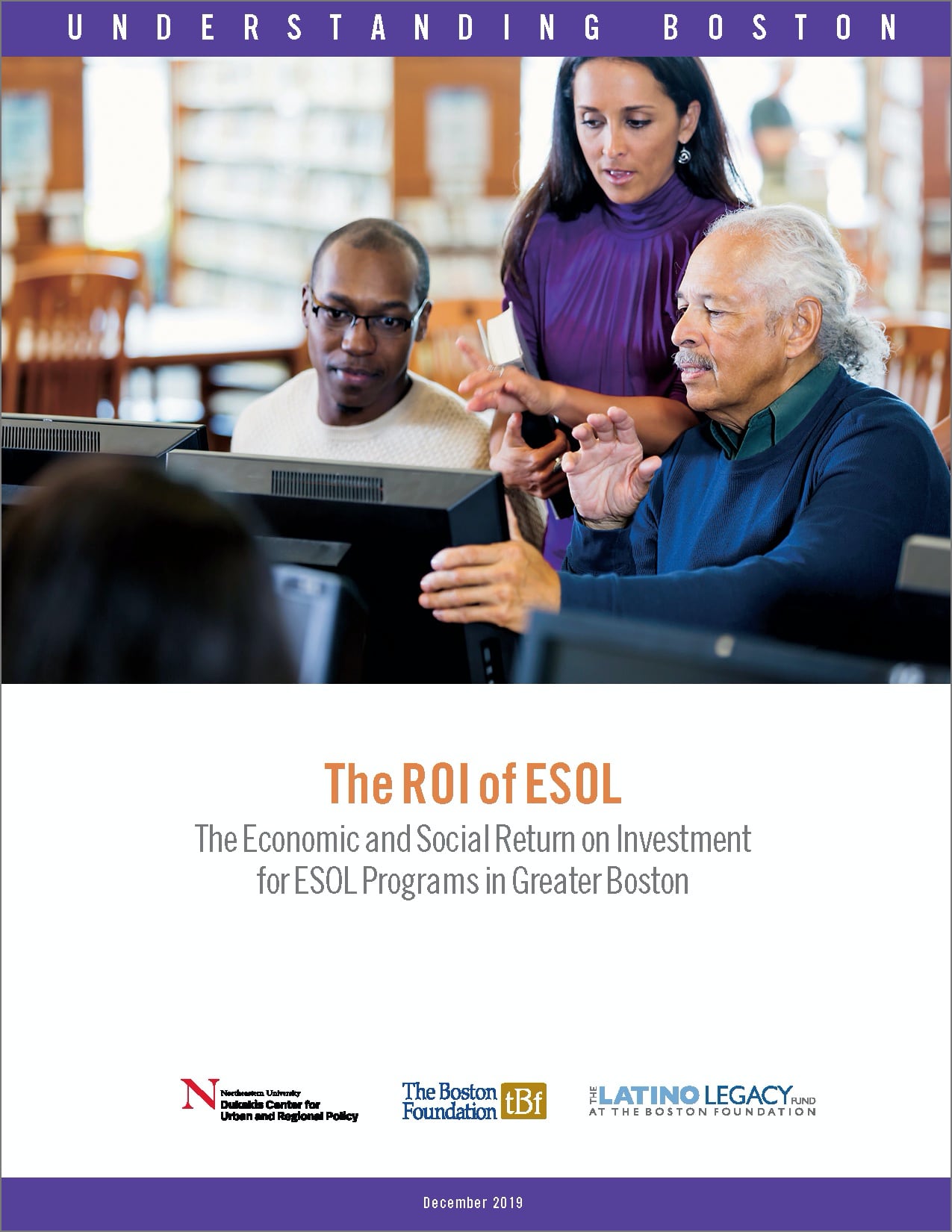Table of Contents
PrefaceExecutive Summary
CHAPTER ONE: Landscape Analysis
Background and Context for ESOL Services
Overview of the ESOL System in Greater Boston
Need for English Language Services in Greater Boston
Supply of ESOL Services in Greater Boston
CHAPTER TWO: Qualitative Analysis: Survey Results and Case Studies by Type of Program Introduction
Findings from Online Self-Administered Survey
In-Depth Interviews with ESOL Program Directors/Managers
CHAPTER THREE: The Economic and Social Return on Investment for ESOL Programs
Measuring the Value of English Language Proficiency
The Effectiveness of the ESOL System in Greater Boston
Assessing the Economic and Social Value of ESOL
CHAPTER FOUR: Conclusion
References and Appendices
Appendix A: Map of Greater Boston (Boston Foundation Catchment Area)
Appendix B: Landscape Analysis Methodology
Appendix C: The Greater Boston ESOL System
Appendix D: ESOL Level Descriptions
Appendix E: Interview Guide Questionnaire
Executive Summary
Recognizing the importance of immigrants to Greater Boston and the value of English classes and other supports to building an inclusive and welcoming community, the Boston Foundation and the Latino Legacy Fund commissioned a study that explores the “return on investment” (ROI) for teaching English to adults who are speakers of other languages. Known as ESOL programs, these services are an important component of adult education and a key piece of the federal Workforce Innovation and Opportunity Act. The result of that study is this report, comprising an analysis of the region’s ESOL landscape that provides background and context for the in-depth case studies and ROI estimates that follow.
We utilized a variety of techniques drawn from quantitative and qualitative research methods. Key steps included:
- compiling existing data on socio-economic and demographic trends of the demand for ESOL services;
- conducting a review of the research literature and policy-related documents;
- interviewing key stakeholders and creating a database of adult ESOL programs in Greater Boston to paint a picture of the sector in broad strokes; and
- collecting data on programs to calculate a return on investment.
We identify key demographic, socio-economic and policy factors that shape the context in which ESOL programs operate, and provide an overview of the ESOL system that highlights the funding sources and stakeholders who are the principal drivers of the system. Our landscape analysis provides an assessment of the need for English language services and a snapshot of the current supply of ESOL services in Greater Boston, with a focus on discovering gaps and barriers. This is followed by our qualitative analysis that draws on our survey results and case studies to offer deeper insights into program operations, including the challenges faced by different types of ESOL programs. Finally, our ROI analysis assesses the economic and social return on investment for ESOL programs in Greater Boston including the effective-ness of the ESOL system with regard to participation, Measurable Skill Gains and long-term outcomes such as employment and wage gains.
Based on the key findings from our analyses, we identified the following gaps and barriers to ESOL services.
- The size of the Limited English proficiency (LEP) population in Greater Boston is roughly 320,000 people, of whom 75 percent (240,531) are working-age adults. This number is expected to increase by 7,740 individuals each year due to continued immigration, further straining the capacity of existing services.
- Currently, there are 116 active ESOL programs in Greater Boston, serving 11,600 adult English language learners annually. While laudable, this limited capacity would need to increase by 20 times to serve all LEP working age adults, as evidenced by the sizeable waitlists for many programs across the region.
- Although ESOL programs are geographically concentrated in Greater Boston, this roughly aligns with the areas that contain the largest population with the greatest need. In addition, programs are serving the language groups most represented in the LEP population, suggesting that services are provided in a fairly efficient manner.
- Populations underserved by ESOL programs are people at either end of the education continuum those without a high school or secondary level education and those with graduate or professional degrees. At the lower end of the distribution, one of the potential barriers identified was the relatively small number of programs offering child-care services.
- Despite most ESOL participants being of working age, only 7 percent of ESOL programs are vocational, suggesting a large misalignment of the types of services offered and the demands of LEP individuals. In contrast, the most common types of ESOL services that are provided are general ESOL, followed by civics/citizenship; the least common are vocational, workplace and pre-academic.
- Of the programs we surveyed, most report having a mix of ESOL-certified and non-certified teachers. Comparatively speaking, vocational and incumbent worker programs are more likely to have certified staff than are community-based programs. However, all programs reported that their teachers have extensive experience teaching English at different levels and in various educational settings, even if they were not always certified. Still, programs report difficulties in retaining staff who can often find better paying and full-time jobs elsewhere.
- According to data from the Department of Secondary and Elementary Education (DESE), just over half (51.2%) of adult ESOL students in Massachusetts achieve at least one Measurable Skill Gain compared with only 45 percent of students in Connecticut, potentially due to the higher share of students that are continuously enrolled in the Commonwealth. In addition, roughly 30 adult ESOL students in Massachusetts attained some sort of secondary credential in FY2017 whereas no adult students achieved this measurable skill gain in Connecticut, as evidenced by the sizeable waitlists for many programs across the region.
- The share of students achieving at least one Educational Functional Level gain has improved from 33 percent in 2002 to 44 percent in 2009 to 51 percent in 2017. At the same time, the cost per advancement has decreased by one-third in Massachusetts from $5,958 in 2002 to $4,024 in 2017, indicating that the ESOL system has become both more effective and more efficient over time. Yet there is considerable variation among even just DESE-funded programs, with performance ranging from meeting only 49 percent of the Measurable Skill Gain target to 136 percent of the target.
- Although DESE-funded ESOL programs have only minimal focus on employment outcomes, roughly one-third of participants in these programs were employed after exiting the program. In contrast, vocational programs with a greater focus on workforce development successfully placed roughly 67 percent of unemployed students within six months of enrollment, with average weekly wages of $460 translating into annual incomes of roughly $23,000.
- Based on the employment and wage gains associated with the one vocational ESOL program for which we have data, these types of programs appear to break even from a societal standpoint within 5 years. Adding in the cost savings associated with the gain in employer-sponsored health insurance produces a break-even time of just 1.5 years. Given that both the economic benefits of higher employment and earnings as well as the additional social benefits from educational attainment, increased consumption and greater civic engagement continue to accrue over the individual’s lifetime, the program clearly yields a net positive return on investment.
Our research points to six broad areas where strategic leadership and investment could lead to transformative changes in the ESOL system. They are:
- the immense gap between the capacity of the system and the need for ESOL services;
- the need for more and better ESOL teacher professional development;
- the lack of student support services to ensure continuous participation;
- the need to grow the number of vocational and workplace ESOL programs to help immigrant workers meet their long-term goals of improving their earnings and career prospects;
- the fragmented nature of the system and need for coordination; and
- the need to support data collection and reporting on ESOL programs and outcomes.
As immigrants account for an ever-increasing share of Greater Boston’s population and workforce, our economy will depend on our ability to cultivate and draw upon the skills and talents of these newcomers. The Workforce Innovation and Opportunity Act passed in 2014 has the potential for re-aligning the supply and demand for ESOL services. Through the unified state plan and common performance measures and reporting requirements, this legislative shift is promoting change in funding streams, data and reporting systems and other institutional structures and processes. Yet progress has been slow as the greater focus on longer-term goals such as employment, education and training outcomes requires more meaningful integration between ESOL and workforce development services. Until we are able to meet the demand for ESOL services in Greater Boston, we will fail to realize the full potential of the economic and social return on this critical investment in our residents.


